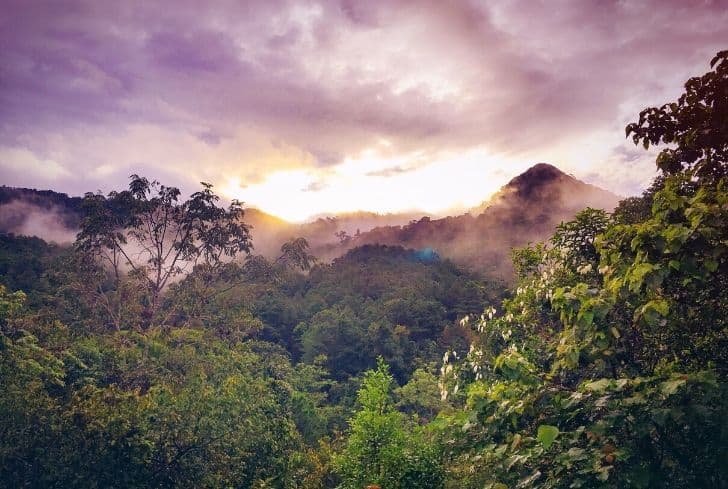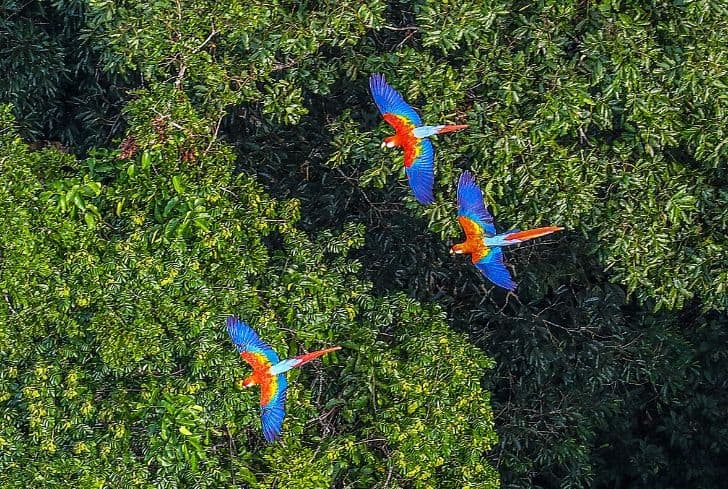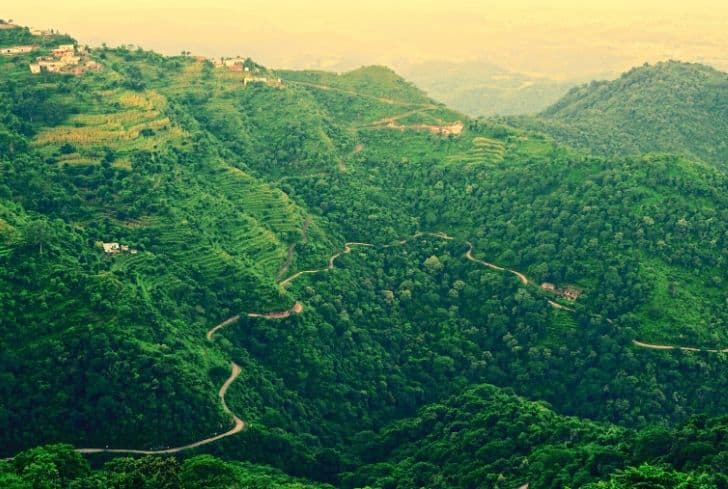Rainforests constitute some of the globe’s most important ecosystems and environments. The globe’s rainforests cover nearly 2% of the earth’s total surface area and host more than 50% of the world’s animals and plants. The rainforests are also regarded as the planet’s regulators of weather and environmental temperatures.
Types of Rainforests
Primarily, there are two types of rainforests:
- Tropical rainforest
- Temperate rainforest
Globally, tropical forests cover a large part of the planet, while temperate rainforests occur in a few regions around the world.
Tropical Rainforests
These rainforests are rightly called the “jewels of the Earth” and the “world’s largest pharmacy,” because more than one-third of natural medicines have been discovered here.
Tropical rainforests are located near the equator between the Tropic of Cancer in the north and the Tropic of Capricorn in the south of the equator. These evergreen forests have a warm and wet climate with consistent rainfall of a minimum of 2,000 mm annually.
Tropical rainforests once covered 14% of the Earth’s land surface, which has now been reduced to only 6%. However, about 80% of the world’s documented species are in tropical rainforests.
Tropical rainforests are found in Southeast Asia, Sub-Saharan Africa, South America, Central America, Australia, and the Pacific Islands. They typically have several layers, such as the emergent, canopy, understory, and forest floor, each with different types of plants and animals adapted for life in that particular area.
Temperate Rainforests
Temperate rainforests account for around one-quarter of the world’s forests in temperate regions. These rainforests spread much further north and south than their tropical counterparts. They exist in North America, Europe, East Asia, South America, Australia, and New Zealand.
Temperate rainforests are moist and grow on mountain ranges, usually along western coasts, where high precipitation occurs due to westerly winds. They also receive over 2,000 mm of annual rainfall but experience drier summers. They have less biodiversity compared to tropical rainforests.
In the past few decades, however, the rainforest has been facing major challenges due to deforestation and degradation due to anthropogenic activities.
Even amidst such environmental problems, the globe still has lots of reasons to recognize and protect the existent rainforests. In this article, we look at the 20 biggest and most popular rainforests in the world.
If man doesn’t learn to treat the oceans and the rainforest with respect, man will become extinct
~ Peter Benchley
19+ Biggest and Popular Rainforests in the World
Some of the biggest popular rainforests include:
1. Amazon Rainforest (South America)
It is the world’s largest tropical rainforest, also known as Amazonia or the Amazon Jungle, boasting 5,500,000 km² of area.
This rainforest covers most of the Amazon Basin of South America, running through Brazil, Peru, Colombia, Venezuela, Ecuador, Bolivia, Guyana, Suriname, and French Guiana, but 60 percent of the Amazon forest is contained in Brazil. The Amazon River also runs through the forest. About
The forest is estimated to be covered by 390 billion individual trees, divided into 16,000 species. Some of the species found in this region include 2.5 million insects, about 2,000 mammals and birds, and tens of thousands of plants.
To date, an estimated 438,000 species of plants of economic and social interest have been registered in the region, with many more remaining to be discovered. The rainforest also contains several species, and among the largest are predatory creatures, including the jaguar, cougar, and anaconda.
In the Amazon River within the forest, electric eels can produce an electrical shock that can stun or kill, while piranhas are known to bite and injure humans. Various species of poison dart frogs found here can produce toxins through their flesh.
There are also numerous parasites and disease vectors. Vampire bats dwell in the rainforest and can spread the rabies virus. Malaria, yellow fever, and dengue fever can also be contracted in the Amazon region.
2. Congo Rainforest (Africa)
The Congo rainforest is the second-largest in the world and covers a total of 1,780,000 km². It is located in Central Africa and has one of the longest rivers running from within it. The rainforest is the largest land cover in Northern Congo.
The Congo River is the world’s second-largest river by volume, draining an area of 3.7 million square kilometers known as the Congo Basin. Nine countries, namely Angola, Cameroon, Central African Republic, the Democratic Republic of the Congo, the Republic of the Congo, Burundi, Rwanda, Tanzania, and Zambia, have part of their territory in the Congo Basin.
There are conventionally six countries with extensive forest cover in the region, which are generally associated with the Congo rainforest: Cameroon, the Central African Republic, the Republic of Congo, the Democratic Republic of Congo (DRC), Equatorial Guinea, and Gabon.
The Congo rainforest is also widely recognized for its high levels of biodiversity, characterized by more than 600 tree species and 10,000 animal species. Some of its most famous residents include forest elephants, gorillas, chimpanzees, okapi, and lions.
3. Valdivian Temperate Rainforest (South America)
The Valdivian temperate rainforest spreads over an area of about 248,100 km² and can be found on the west coast of southern South America in Chile and Argentina.
Angiosperm trees, bamboo, ferns, conifer trees, narrow coastal strips, ice sheets, glaciers, and a central valley highlight the forest. The temperature here is usually humid due to heavy rain. It is generally very foggy.
The rainforest is named after Valdivia in Southern Chile. The forest is famous for its endemic plants and 150-foot-tall trees, in addition to rare species of animals. Some of the old tree species are Alerce and Olivillo.
4. Daintree Rainforest (Australia)
The Daintree tropical rainforest is found on the northeast coast of Queensland, Australia, named after Richard Daintree, and covers around 2,600 km². The area between the Bloomfield River and Mossman Gorge is entirely covered by the forest and also has the Daintree National Park. Its main river is the Daintree River.
The forest is home to some of the earliest plants on Earth, such as the Lycopsida and Psilotopsida. It contains the highest number of animals and plant species that are very rare to find.
5. Southeast Asian Rainforest (Asia)
The forest is found in Asia, covering Indonesia, Laos, Cambodia, and the Malay Peninsula. It once covered even a greater area in Asia, but deforestation destroyed most of the regions of the rainforest. The forest is home to many rare birds, mammals, amphibians, and reptiles.
At one point, there were 200 different species of trees in a hectare, but deforestation has put those species in danger. One exciting feature of this rainforest is the dominance of one family of trees, with numerous species of animals, such as Bengal tigers, Dawn bats, King Cobras, and proboscis monkeys, among others.
6. Tongass National Forest (North America)
The Tongass National Forest is the biggest national forest in the United States. It extends to an area of 17 million acres. It is home to rare and endangered species of fauna and flora. It covers the peaks of the Coast Mountains, fjords, glaciers, and islands of the Alexander Archipelago.
Wildlife found here is abundant throughout, with two main predators being wolves and brown bears. Marine mammals are also found along the shores.
7. Kinabalu National Park (Malaysia)
Also known as Tama Kinabalu, it is found on the west coast of Sabah, Malaysian Borneo. It was established in 1964 and was the first national park in Malaysia. The forest is also Malaysia’s first World Heritage Site.
Kinabalu National Park is home to more than 4,500 species of flora and fauna, including 100 different species of mammals. Mount Kinabalu is the highest mountain on the island of Borneo, attracting many visitors and climbers to the park.
8. Santa Elena Cloud Forest Reserve (Costa Rica)
This forest is in the Costa Rican reserve found along the Cordillera de Tilaran in the Alajuela and Puntarenas provinces. It consists of about 26,000 acres of cloud forest. It’s also known as the “terrain of the cloud forest.” The forest is covered with a lush garden of mosses, flowers, ferns, and epiphytes on nearly every tree.
The forest consists of six ecological zones containing more than 2000 species of plants, 80 species of mammals, 400 species of birds, around 100 amphibian and reptile species, and thousands of insects.
9. Sinharaja Forest Reserve (Sri Lanka)
The Sinharaja forest covers a total area of 8,864 square kilometers. The forest, which is located in Sri Lanka, is home to about 830 endemic species, such as trees, insects, birds, reptiles, mammals, and amphibians.
It was declared a World Biosphere Reserve in 1978 by UNESCO. It has dense vegetation, so it’s hard to see wildlife here. Some of the wildlife found in this forest includes leopards and elephants.
10. Pacific Temperate Rainforest (North America)
It is found in North America along the western side of the Pacific Coast Ranges, and it’s the largest temperate rainforest in the world. Its ecoregions are predominantly composed of conifers.
Redwood trees dominate the southern limit of northern California and are the tallest, biggest, and longest-living trees on Earth.
It is estimated that most redwood trees have existed for more than 2,000 years, reaching heights as high as 90 meters. It also has different and numerous animal species, including black bears, grizzly bears, endangered spotted owls, wolves, Sitka deer, and bald eagles.
11. Sundarbans Reserve Forest (India & Bangladesh)
The Sundarbans Reserve Forest is within Bangladesh’s area and covers 40 percent of India. The entire land area covered by the forest is 10,000 km².
It is one of the natural mysteries of the world because of its location, which includes the Padma, Brahmaputra, and Meghna river basins. Mangrove trees dominate the forest and serve as a habitat for the Royal Bengal tiger.
12. Monteverde Forest (Costa Rica)
Located in Costa Rica, the forest is named after Monteverde and covers an area of more than 10,500 hectares. Tropical green vegetation covers most of the area, with nearly 2,500 plant species, 120 amphibian and reptilian species, thousands of insects, 400 varieties of birds, and 100 different mammals.
The forest also has natural rivers, medicinal herbs, streams, and waterfalls, and because of these natural resources, it’s always referred to as “the virgin forest.”
13. Papua Rainforest (Papua New Guinea)
Papua rainforest is among those with the most diverse and unique animal and plant species on Earth because of its dense mangrove trees. It is shared between two countries – Indonesia provinces of West Irian Jaya and Papua to the west and Papua New Guinea on the eastern side.
Two-thirds of the plant and animal species in the forest are in New Guinea. The unique animals include carnivorous mice, giant pigeons, kangaroos with the ability to climb trees, and big rats. The forest also hosts the largest number of orchid species on the planet.
14. Sapo National Park Rainforest (Africa)
Sapo National Park Rainforest is located in southwest Liberia, Sinoe County. It is the largest protected area and the only national park in the country. The area it covers, which is 1,804 km², is the second-largest in West Africa.
According to Conservation International, it has the most numerous mammal species diversity of any area worldwide and is regarded as an ecoregion since it’s located in the Western Guinean lowland forest area.
Animal species found here include elephants, pygmy hippopotamus, African golden cat, African grey parrot, great blue turaco, monkeys, bee-eaters, sunbirds, crocodiles, and the endangered Diana monkey, among many others.
15. Bosawás Biosphere Reserve (Nicaragua)
The Bosawas Biosphere Reserve in northern Nicaragua stretches over an area of 2 million hectares, comprising around 15% of the total land area of Nicaragua, making it the second-largest rainforest in the western hemisphere after Brazil’s Amazon. Bosawás is mostly unexplored and extremely rich in biodiversity.
It has very high botanical diversity and hosts many invertebrates (an estimated 100,000 to 200,000 insect species) and vertebrate species. The forest was designated as a UNESCO biosphere reserve in 1997.
The booming livestock industry of Nicaragua is the main threat to the rainforest. Ranchers who migrate to the reserve in groups often pay land traffickers to secure title to land illegally.
16. Hoh Rainforest (North America)
The Hoh Rainforest is considered one of the largest temperate rainforests located in Western Washington State, USA. It is a part of the Olympic National Park, which is protected from commercial exploitation such as mining.
The 24 miles of the area of this forest, along with the Hoh River, is also the world’s one of the few ecosystems that have remained unchanged even for a thousand years. That is why it has been awarded as a “World Heritage Site and a Biosphere Reserve” by UNESCO.
The rainforest is mostly covered with hanging ferns and mosses. The main trees in the Hoh rainforest are Sitka spruce and western hemlock. Animals found in the Hoh rainforest include Bobcats, Black-tailed deer, Coyotes, Cougar Wolves, Fishers, Olympic Black bears, Porcupines, Pumas, Raccoons, Roosevelt elk, and Snowshoe Hares.
Animals endemic to the Hoh Rainforest include the Olympic chipmunk, Olympic marmot, snow mole, and short-tailed weasel.
17. Perućica, Sutjeska National Park (Europe)
Located in Bosnia and Herzegovina, close to the border with Montenegro, Perućica is also part of the Sutjeska National Park. It is the oldest and largest national park on the continent. Perucića is one of the last remaining primeval forests in Europe and is highly conserved.
This rainforest reserve is a UNESCO-recognized site with a total area of 1400 hectares. It is home to vegetation that is believed to be 300 years old. It also has the tallest measured Norway spruce (63 m) as one of its assets.
18. Eastern Australian Rainforest
The Eastern Australian rainforest is located along the east coast of Australia from New South Wales to southern Queensland. This rainforest is considered a temperate rainforest, and its size is around 55 million acres.
The Eastern Australian Rainforest was once the largest rainforest in Australia, but due to the clearing of eucalyptus woodlands and dry forests for urban development, the rainforest became smaller and smaller.
This rainforest is dominated by peppermint eucalyptus trees, shrublands, affiliated sandplain vegetation, and around 1,200 more vascular plants. The shrub species that can be found in this rainforest are Epacridaceae, Myrtaceae, Rutaceae, Fabaceae, Proteaceae, and Cyperaceae.
The local wildlife that can be found in the rainforest are koalas, kookaburra kingfishers, velvet worms, gang-gang cockatoos, crimson rosellas, striated thornbills, red goshawks, swift parrots, regent honeyeaters, and many other species of birds.
19. Luzon Rainforest
The Luzon rainforest is a tropical rainforest located in the Philippines. This rainforest spreads over around 27 million acres, and it is a mix of lowland rainforest and montane forest, both on eruptive and non-eruptive mountains. This rainforest is the habitat of at least 31 endemic mammal species that are not seen anywhere else in the world.
Included in this rainforest are the forests located on the Luzon island of the Philippines, including the Batanes, Babuyan Islands, Catanduanes, Polillo Islands, and Marinduque. Moreover, the ecoregion of this rainforest also includes the Sierra Madre, the Zambales Mountains, and the northern Cordillera Central.
Flora species such as dipterocarp trees, canopy, rattans, lianas, epiphytic ferns, orchids, and many other species can be found in the rainforest. On the other hand, this rainforest is also a habitat for endemic species of mammals and other wildlife, including the Philippine eagle, Myer’s snake, Philippine crocodile, and many other wildlife species.
20. Cardamom Mountains Rainforest
The Cardamom Mountains rainforest is a tropical rainforest ecoregion located in Southeast Asia. Included in the ecoregion are the Cardamom and Elephant Mountains, adjacent coastal lowlands in eastern Thailand and southwestern Cambodia, and the island of Dao Phu Quoc, located in Vietnam.
This rainforest has a size of 10 million acres, which is not yet completely explored as it is very difficult to access due to its location, difficult terrain, and quite small human population.
The Cardamom Mountains rainforest is home to different conifers, canopies, laurels, myrtles, beechnuts, and palms. understory shrubs, epiphytes, tree ferns, orchids, and many other plant species.
On the other hand, this rainforest is also home to different wildlife populations, including banteng, gaur, dhole, gibbons, elephants, leopards, tigers, Sumatran serow, 450 species of bird, and other endemic species.
References:
https://www.nationalgeographic.com/environment/habitats/rain-forests/








